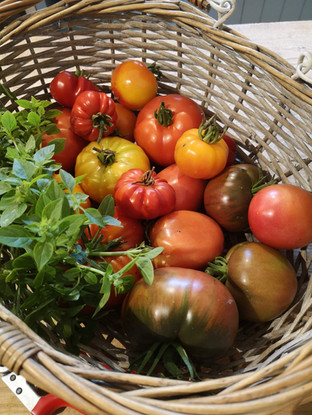BECKY CRAVEN - KITCHEN GARDENER
- SSAW Collective
- Jul 20, 2020
- 4 min read
Updated: Nov 6, 2020
I believe the most successful kitchen garden, whatever its size, is a result of its relationship and value to the community it supports. There is a perfect symbiosis, where the soil, and equally the plant, is nourished by the gardener and the plant returns beauty, scent, energy, minerals, and joyful flavour to the community. The balance of the community is sensitive, as with many organic systems. We only nourish ourselves properly if we listen to our bodies and respond to what they really need. In the same way, we must strive to listen to the garden and the soil, address imbalances - sometimes by observation and interaction, and sometimes through reaction. Learning how to do this is a life’s work.

"WHEN WE ARE CONSCIOUS OF AND UNDERSTAND THE STORY OF THE INGREDIENT, IT BECOMES MORE VALUED. THE STORY DOESN’T NEED TO BE COMPLICATED, IN FACT, SOMETIMES THE SIMPLEST, TRUE STORY CAN ADD FLAVOUR AND COLOUR TO AN OTHERWISE ORDINARY SEEMING VEGETABLE"
Graduating from a fine art degree in 2008, I raided the library for books about food security and became sucked into a long wallow of pessimism and doom. Eventually I decided that I could be a positive part of the movement to make food better within my own community in Oxford. I started working at the newly opened Magdalen Arms under head chef Tony Abarno. The guiding principle here appeared to be the link between the kitchen and their suppliers; the chef and the farmer. When we are conscious of and understand the story of the ingredient, it becomes more valued. The story doesn’t need to be complicated, in fact, sometimes the simplest, true story can add flavour and colour to an otherwise ordinary seeming vegetable. The good chef takes their trust for the supplier all the way to the plate, showing each ingredient care and respect. Simply, the best dishes are those created to honour and celebrate the ingredients, and at the same time, they honour the relationship between the cook, the diner and the grower. It was this part of the relationship which I was keen to explore in more detail.

As a kitchen gardener, I like everyone to be involved in the planning process that way the community is invested. In late November, I gather my notes, lists and charts, to see what has done badly or well. Seed catalogues are consulted and old favourites are carefully added to the list, often double or triple checked, along with new, exciting varieties boasting resilience to pests or a particularly pleasing looking stripe or shade. The cooks remind me of the fleshiest tomatoes, perfect for sauce, or the climbing beans that can be dried, shelled and stored, the herbs that add so much flavour. The diners bring their memories of hot summer evenings and the unforgettable sweetness of an aubergine which has never been in a fridge nor a lorry, slowly baked, skin charred and flesh pulled apart with forks.
I first became fully immersed in a garden and its community of people and plants when I spent almost four years living on site at the home of Matthew Rice and Emma Bridgewater, growing, cooking and eating the garden. As with a professional kitchen, this provided an intense learning experience. Daily, whilst walking round the garden weeding or watering, I would take a mental note of what was nearly ready, what needed using up, and what was coming to the end. Meals would create themselves in my head. Everyone loved to visit the garden and would leave hungry as I conjured in their mind’s-eye a year of suppers, where previously they had just seen plants.
Watching the plants, soil and landscape respond to each new environmental stimuli, I found that the best teacher happened to be nature itself. I learned to appreciate the deeper connection between not only the garden’s human community but the vast wild populations living within her.
I was hugely privileged to work with The Land Gardeners and witness the same love and lavish attention given to the soil and its inhabitants, that I had previously extended only to plants as a gardener, and to ingredients as a chef. We fed the soil over and over, making compost heaps akin to cakes and lasagnes with organic, high quality natural ingredients grown especially for the purpose. We fed and monitored the compost like it was a newborn. I was gripped by the unquantifiable amounts of bacteria, funghi, archaea and protozoa in the soil, and the animals and insects who depend on the plants or each other for survival. I now understood the whole circle. Plants and the soil are the most important part of the community. Each plant feeds the soil microbes, and they in turn release back to the plant minerals which otherwise remain locked in the soil. The plant’s nutrition and flavour for the consumer can only ever be as good as the health of the community of the soil they are grown in. You get out what you put in, you are what you eat. So is the same true of all of us. We must commit to nourishing each and every part of the community, with balance and love and holistic consideration. A magical, thriving and alive kitchen garden needs living and vital soil, nurtured and guarded by the gardener, who is kept strong by delicious and joyful food, that is cooked with care and shared together. This relationship trusts that everyone will perform their part and it is vital that we do not forget our role, as the grower, to nourish our community.

@beckygrowsthings
21/07/2020






Comments